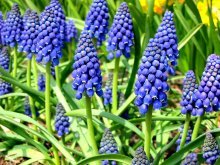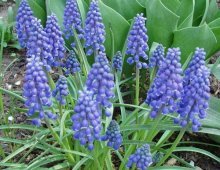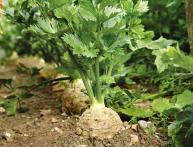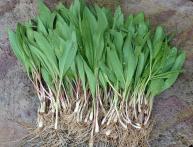The correct approach to planting and caring for muscari
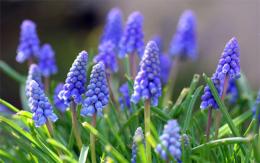
If you have long dreamed of a beautiful plot with flowers, but want to spend as little effort as possible to realize it, then Muscari is perfect for you. Since it is a perennial, it will delight you with its flowering for many years. Its color scheme will add brightness to any area, in addition, it goes well with many plants (for example, tulips, daffodils).
Content:
- Description of the species
- Advantages, features
- Features of cultivation: soil selection, planting, watering, fertilizer
- How to properly store bulbs?
Description of the species
Muscari, also called Mouse Hyacinth, is distributed throughout almost all of Eurasia and is found in North Africa. Found in mountains, forests, forest edges and meadows. The flower got its name due to its smell, similar to musk. The genus contains about 60 species. Muscari is a perennial bulbous plant. Its height is 10-30 centimeters. The bulbs are 2 cm in diameter, light in color with outer scales.
The height of the bulbs ranges from 1.5 to 3.5 centimeters. Muscari has linear leaves, reaching a length of up to 17 cm, growing from the root. Number of leaves up to 6 pieces. Leaves often appear in the spring; if they grow in the autumn, they have to overwinter under the snow. The perianth is cylindrical, has 6 leaves fused together. The length of such leaves is from 0.4 to 0.5 cm.
These leaves are collected into a single racemose inflorescence. Color varies from white to dark blue. Muscari has a pleasant but intoxicating aroma. The stamens, six in number, are attached in a double row to the perianth. The fruit is a three-lobed capsule. The shelf life of the seeds lasts up to a year; they are wrinkled, round, black, and small. Almost all types are decorative.
The most common varieties include: Oshe muscari, grape-shaped muscari, broadleaf, pale, Christmas Pearl muscari, Blue Spike terry muscari.
Advantages, features
This plant is widely popular among gardeners and simply lovers of beautiful flower beds. It makes a wonderful addition to flower beds and borders, and also looks great in flowerpots. Muscari has the ability to grow quickly; a nest is formed from 1 bulb per season. Muscari will not keep you waiting for long until it fills the flowerbed.
There are practically no difficulties in growing a flower. The plant is not picky about care. Muscari will perfectly decorate your flowerbed and combine harmoniously with many flowers. The only thing worth considering is that while the foliage dies off after flowering, it can cover short plants, so it is necessary to plant plants nearby that can hide the wilted foliage with muscari.
Features of cultivation: soil selection, planting, watering, fertilizer
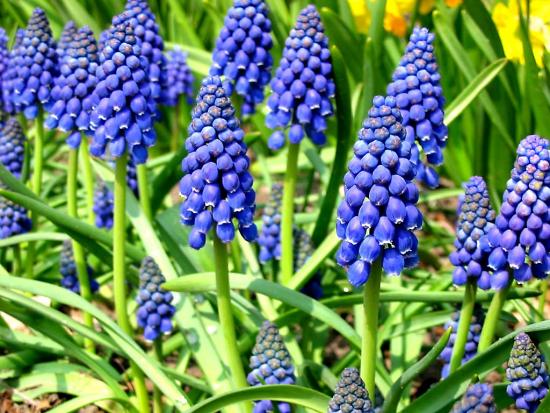
Muscari planting time and soil selection. As mentioned earlier, muscari is not a picky plant, but it also requires care. It is preferable to plant muscari bulbs in well-drained soil. Sandy loam soil is best, which you can create yourself by mixing the soil with river sand. Planting should be done in the autumn until October.
How to properly plant muscari bulbs in the ground? Before planting, carefully inspect the seeds and remove any that are unsuitable for landings (damaged, rotten). For disinfection of bulbs, 2% karbofos solution is perfect; keep them in this solution for up to half an hour, then place them in 1% potassium permanganate solution, also for 0.5 hours.
The day before planting the bulbs, the holes must be watered generously. Immediately before planting, add a little river sand to each hole. Plant as follows: plant large bulbs to a depth of 7 cm with a distance of 8 cm, small bulbs to a depth of 3 cm with a distance of 3 cm.
When and how is watering carried out?
Watering must be carried out before the growing season of the plant; in the future, muscari does not require abundant watering, only in the case of too dry soil. With abundant watering, the water does not completely evaporate and stagnation occurs, because of this the bulbs can rot.
Fertilizing the soil. If muscari is planted on infertile soil, then it is worth enriching it with organic fertilizers; compost or humus is best suited. It is better, of course, to fertilize the soil before planting the plant, and not after.
Care during plant flowering. Muscari blooms for 3-3.5 weeks. During this period, it does not require significant care, you just need to loosen the soil after watering so that it is enriched with oxygen. In addition, do not forget that you need to take care behind the flowerbed and pull out the weed in a timely manner.
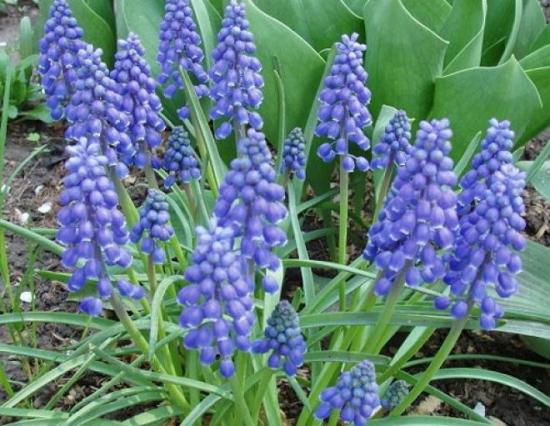
Reproduction. Muscari is capable of reproducing abundantly, but to prevent this, it is worth cutting off the flower stalks after flowering. After all, this plant reproduces not only vegetatively, but also by self-sowing. Only a small number of flower stalks should be left for the seeds to ripen.Young ripened seeds germinate within a year after planting.
They are planted to a depth of no more than two centimeters. The first shoots indicate that the process of bulb formation has begun. The first flowering will occur in two to three years.
How to properly store bulbs?
Despite the fact that muscari is a perennial, there may still be a need to dig up the bulbs for some reason. You should dig up the bulbs only after the leaves of the plant begin to dry, not before.
The dug up bulbs must dry for 2-3 days, then they are placed in sand. Don't forget to check the safety once a week bulbs and remove spoiled or rotten ones. The storage temperature should be 17 degrees and the humidity 70 percent. Grow Muscari with joy and enjoy its flowering!
Video about the muscari flower:

